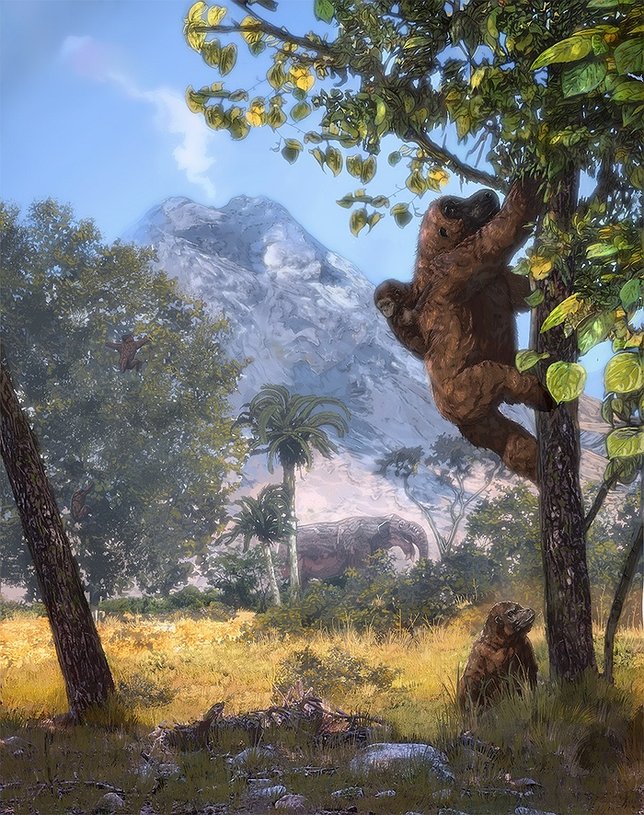Because living apes easily reach eatable fruit in trees with their upright bodies, anthropologists have long thought that this is a primary reason why they evolved over millions of years to have an upright torso. But now new research by an international team of paleontologists is suggesting apes ate leaves in forests some 21 million years ago, and this drove their evolution to becoming upright creatures.
James Rossie, PhD, Associate Professor in the Department of Anthropology in the College of Arts and Sciences at Stony Brook University, a member of the international collaboration, and his co-authors describe the finding in a newly published paper in Science, along with a complimentary Science paper highlighting the grassy woodland habitats of the time, which sheds light on the lives of ancient apes, their habits, and thus evolution.
The two papers grew out of a U.S. National Science Foundation (NSF)-funded collaboration of international paleontologists, known as the Research on Eastern African Catarrhine and Hominoid Evolution Project, or REACHE.
New research articulated in these papers provides evidence from the REACHE project that pushes the timeframe back on when apes became upright, and what they ate, forcing scientists to rethink ape evolution.
Scientists involved focused on different aspects of early ape paleoenvironments. The study, led by University of Michigan Professor Laura MacLatchy, revolves around a 21-milliion-year-old ape fossil called Morotopithecus, from Moroto, an upright ape.
The team assessed the biomechanics of Morotopithecus, its eating habits, and evidence about its habitat. They detailed these in the paper titled “The evolution of hominoid locomotor versatility: Evidence from Moroto, a 21 Ma site in Uganda.”
Rossie assisted in the work and re-analysis of the dental and jaw-bone fossils from Moroto, a key aspect to the finding.
“The femur and lower back anatomy of this ape reveals that it climbed trees the way modern apes do, and this is the earliest evidence for this adaptation by at least seven million years,” says Rossie. “More surprisingly, Morotopithecus shows dental traits indicative of folivory or leaf-eating instead of frigivory.”
MacLatchy and the team examined fossils found in a single stratigraphic layer, including fossils of this oldest ape over that time at Moroto. Within this layer included fossils of other mammals, ancient soil evidence and tiny silica particles from plants. They used this evidence to recreate the environment of Moroto.
From this, they determined Moroto’s living environment to be “water stressed,” meaning the creatures lived in a landscape that included periods of rain and aridity, which is evidence of an open woodland with broken canopy forests composed of trees and shrubs.
Rossie explained that an assessment of Morotopithecus’ molars exhibit an elongation with well-developed crests, ideal for shearing leaves. Molars designed to crush fruits are more rounded. Carbon isotope signatures of the enamel of these apes indicated they fed on water-stressed plants, meaning that they were subjected to seasonal periods of dryness.
The work at Moroto is part of a broader endeavor, in which the researchers used a set of environmental proxies to reconstruct the vegetation structure from nine fossil ape sites across Africa. Rossie co-directs one of the major field projects that pooled the team’s efforts to document environments across the continent.
In the companion paper, titled “Oldest evidence of abundant C4 grasses and habitat heterogeneity in eastern Africa,” the researchers reconstructed the paleoenvironment at each location and used carbon isotope analyses of ancient soil organic matter, plant wax biomarkers and phytoliths found at each site.
The authors summarize that the “results demonstrate that between 21 and 16 Ma, C4 grasses were locally abundant, contributing to heterogeneous habitats ranging from forests to wooded grasslands. These data push back the oldest evidence of C4 grass-dominated habits in Africa—and globally—by more than 10 million years, calling for revised paleoecological interpretations of mammalian evolution.”
Previously, researchers believed equatorial Africa during the Early Miocene was thickly covered in forest, and that woodlands and grasslands emerged 7 to 10 million years ago, but this study suggests it was more like 21 million years ago.
Robin Bernstein, Program Director for Biological Anthropology at the NSF, commented on the two papers and the implications of the research:
“The findings have transformed what we thought we knew about early apes, and the origin for where, when and why they navigate through the trees and on the ground in multiple different ways,” said Bernstein. “For the first time, by combining diverse lines of evidence, this collaborative research team tied specific aspects of early ape anatomy to nuanced environmental changes in their habitat in Eastern Africa, now revealed as more open and less forested than previously thought. The effort outlines a new framework for future studies regarding ape evolutionary origins.”










